Электронная книга: Emil Simiu «Wind Effects on Structures. Modern Structural Design for Wind»

|
Provides structural engineers with the knowledge and practical tools needed to perform structural designs for wind that incorporate major technological, conceptual, analytical and computational advances achieved in the last two decades. With clear explanations and documentation of the concepts, methods, algorithms, and software available for accounting for wind loads in structural design, it also describes the wind engineer's contributions in sufficient detail that they can be effectively scrutinized by the structural engineer in charge of the design. Wind Effects on Structures: Modern Structural Design for Wind, 4th Edition is organized in four sections. The first covers atmospheric flows, extreme wind speeds, and bluff body aerodynamics. The second examines the design of buildings, and includes chapters on aerodynamic loads; dynamic and effective wind-induced loads; wind effects with specified MRIs; low-rise buildings; tall buildings; and more. The third part is devoted to aeroelastic effects, and covers both fundamentals and applications. The last part considers other structures and special topics such as trussed frameworks; offshore structures; and tornado effects. Offering readers the knowledge and practical tools needed to develop structural designs for wind loadings, this book: Points out significant limitations in the design of buildings based on such techniques as the high-frequency force balance Discusses powerful algorithms, tools, and software needed for the effective design for wind, and provides numerous examples of application Discusses techniques applicable to structures other than buildings, including stacks and suspended-span bridges Features several appendices on Elements of Probability and Statistics; Peaks-over-Threshold Poisson-Process Procedure for Estimating Peaks; estimates of the WTC Towers’ Response to Wind and their shortcomings; and more Wind Effects on Structures: Modern Structural Design for Wind, 4th Edition is an excellent text for structural engineers, wind engineers, and structural engineering students and faculty. Издательство: "John Wiley&Sons Limited"
ISBN: 9781119375906 электронная книга Купить за 12643.68 руб и скачать на Litres |
Другие книги автора:
| Книга | Описание | Год | Цена | Тип книги |
|---|---|---|---|---|
| Design of Buildings for Wind. A Guide for ASCE 7-10 Standard Users and Designers of Special Structures | ASCE 7 is the US standard for identifying minimum design loads for buildings and other structures. ASCE 7 covers many load types, of which wind is one. The purpose of this book is to provide… — John Wiley&Sons Limited, электронная книга Подробнее... | электронная книга |
См. также в других словарях:
Structural design — In structural engineering, structural design is an iterative process of applying engineering mechanics and past experience to create a functional, economic, and, most importantly, safe structure for the public to inhabit or to use. Using… … Wikipedia
Wind turbine design — An example of a wind turbine, this 3 bladed turbine is the classic design of modern wind turbines Wind turbines History Design … Wikipedia
stage design — Aesthetic composition of a dramatic production as created by lighting, scenery, costumes, and sound. While elements such as painted screens and wheeled platforms were used in the Greek theatre of the 4th century BC, most innovations in stage… … Universalium
garden and landscape design — Introduction the development and decorative planting of gardens, yards, grounds, parks, and other types of areas. Gardening and landscape design is used to enhance the settings for buildings and public areas and in recreational areas and… … Universalium
interior design — 1. the design and coordination of the decorative elements of the interior of a house, apartment, office, or other structural space, including color schemes, fittings, furnishings, and sometimes architectural features. 2. the art, business, or… … Universalium
History of structural engineering — The history of structural engineering dates back to at least 2700 BC when the step pyramid for Pharaoh Djoser was built by Imhotep, the first engineer in history known by name. Pyramids were the most common major structures built by ancient… … Wikipedia
